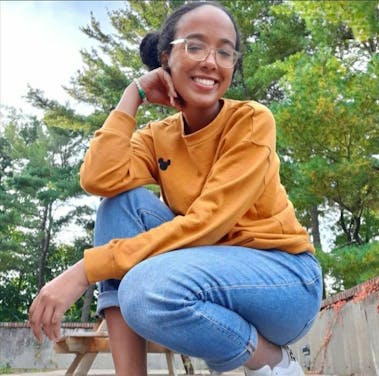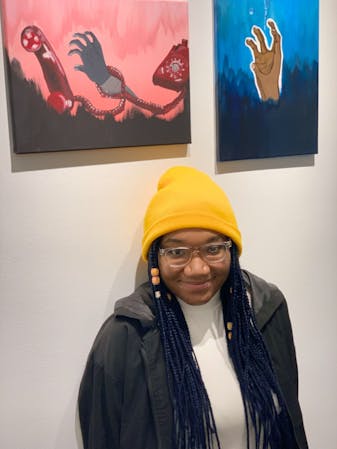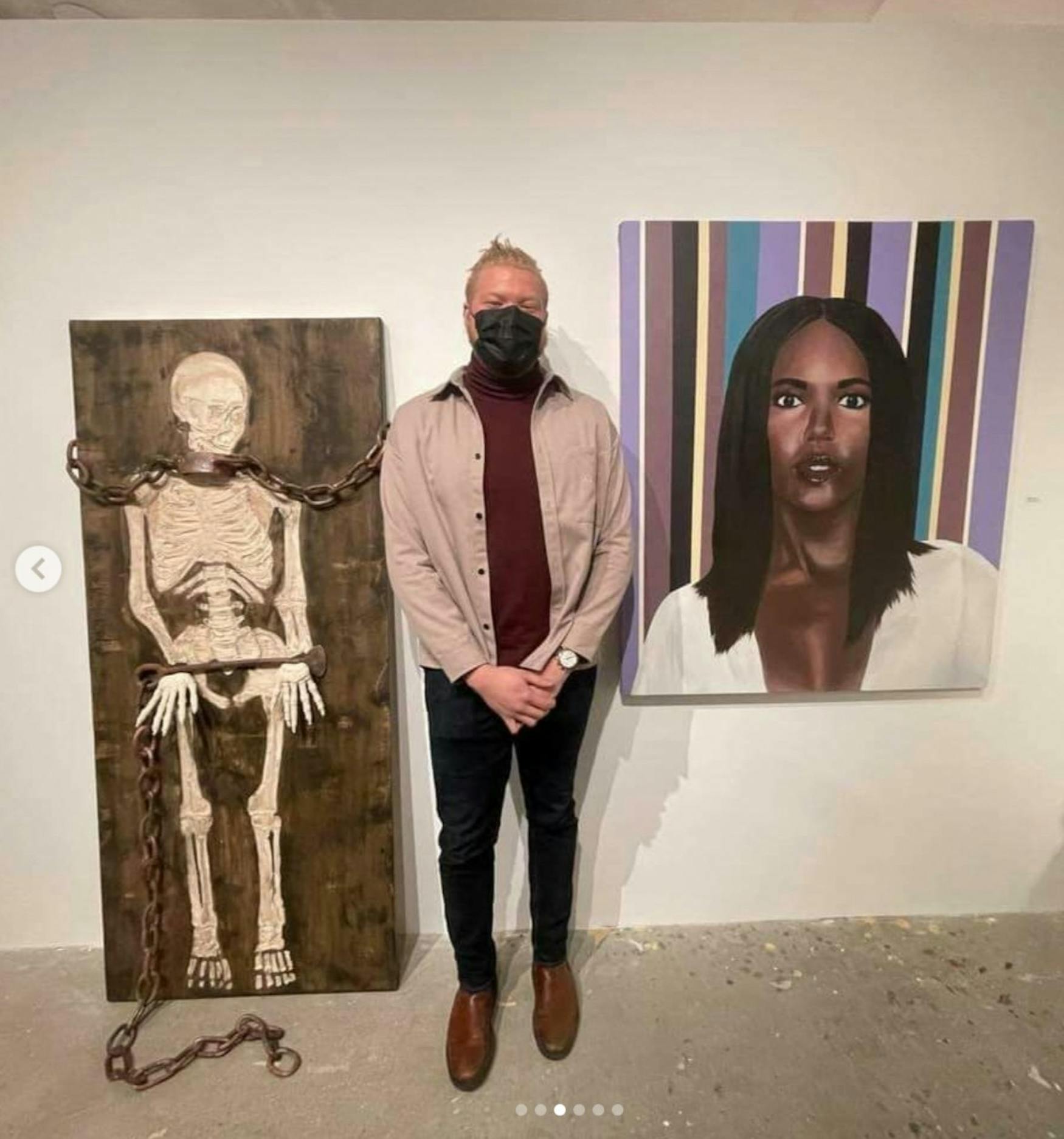Artists of our time
The Justice spoke to three BIPOC artists about their art and their experiences as artists at Brandeis.
“Aside from art being just an expression of your ideas and expression of who you are and what you think the world is about, I think it’s just also a connection tool,” Jonathan Joasil ’22 said when asked how he defines art during our April 7th Zoom interview. Jonathan is a Black painter and visual artist whose work has been featured in the senior exhibition at the Dreitzer Art Gallery in Spingold Theater.
Jonathan will graduate in May as both a Biology and a Health, Science, Society, and Policy major, with a minor in Studio Art. While his main fields of study are based in STEM, art has been an important part of his life since he was young; he started drawing when he was about four years old. Jonathan said that when he was younger, he would always find something interesting to draw during school. In eighth grade, he created a mural of Charlie Brown and Snoopy.
“Reflecting back on this,” Jonathan said, “I realized I’ve kind of been doing these larger-scale things, and I did not even realize that then. It was more like pure enjoyment back then, and now I am really thinking about [the art I do].”
When Jonathan started high school, the heavy workload he had at the technical high school he attended in New York City meant he no longer had time to explore his passion for art. But, as he explained, “When I got to Brandeis, I realized an art class was required, and I was like ‘Wow, I can take more of these classes.’ And in my sophomore year, I thought, ‘Let me do the minor.’”
Like Jonathan, Delaine De La Cruz ’24, a Dominican Afro-Latina Film and Interactive Media major, also found her passion when she arrived at Brandeis. Delaine practices various types of art, from dance to musical theater to photography, and, most recently, filmmaking.

DELAINE: Delaine Gneco De La Cruz '25 discovered her passion for filmmaking in her first semester at Brandeis.
“My first semester [at Brandeis] I fell in love with the film major,” she said during our April 7 Zoom interview. Delaine grew up dancing and did so for almost 15 years and was planning on majoring in dance. But after discovering her love for filmmaking as a first-year, she decided to pursue film instead.
“For me, art is an expression; I think ‘How can I tell the story I want to tell?’” said Delaine. She explained how each form of art is powerful and unique for different reasons. “With dance,” she said, “there is no language you need to speak to understand because there are no words. In theater, there is power in the way it tells a story in a very performative way. With photography, you have the ability to capture one second, one moment, and in the only frame you can still say a lot.”
When it comes to art, Delaine practically does it all but says if she had to choose a favorite, it would be filmmaking. “Because film is so interdisciplinary, I [am] able to combine all of my creativity into this one medium,” she explained.
Delaine admitted that she did not always love producing and directing. In high school, she was tasked with what seemed to her an impossible assignment: to write, direct, and film a 10-minute short film. “It was funny because at that time I wasn’t interested in film at all. I went to the movies, but I was like, ‘I don’t want to be behind the camera,’” she said. During the making of the short film assignment, Delaine remembers thinking, “If this is so hard, I can’t imagine how people do, like, two hours.” It was not until she saw the final product of this project that she could see herself directing and producing films in the future.
Unlike Jonathan and Delaine, Bintou Baysmore ’25, a Black visual artist who creates drawings, paintings, and digital works, was already set on pursuing art as a career when she entered Brandeis. She explained during our Zoom interview on April 7, “I grew up in art since I was young. I don’t really like to say natural talent because you always have to work and challenge yourself to become better.”
While art has always been there for her throughout her life, she says it was not until her junior year of high school that she became very serious about it. Bintou is planning on double majoring in Studio Art and Computer Science and hopes to pursue art and animation.

BINTOU: Bintou Baysmore ’25 is pictured with her pieces “Blood Thinning” (left) and “Emotional Addict” (right), which were were displayed in early March.
Art and identity
For the BIPOC artists I spoke to, identity and culture play into their work in a variety of important ways and can also create unique pressures and expectations.
Jonathan said that being a BIPOC artist makes his art more interesting, explaining that he has been able to add elements of what it means to be a part of the Black community and an artist of color into his work. “It is not a matter of ‘I have this identity, and I need the world to see this identity.’ But rather I think of the fact that this is who I am, and why shouldn’t the world get to see that?” he explained.
During our conversation, we discussed his art pieces and the important messages that reside within them. Jonathan explained that he is passionate about social justice and decided to combine this passion with his other passion, art.
He spoke about how he is currently exploring the idea of Black women being pressured to have straight hair within the workplace through his art. In one of his pieces, a Black woman with straight hair is shown on top of a clean-cut striped background that represents the professional world and what is seen as presentable. Juxtaposed with the second painting that he is currently working on — a painting of a Black woman, this time with curly hair and a background representing disorder and distraction — the two pieces tell a story about the important and complicated relationship of Black women to their hair and the ways that perceptions, prejudices, and stereotypes impact this relationship.
Jonathan described another one of his pieces that examines the way that the oppression of Black people is deeply ingrained within our systems. For this piece, he carved a skeleton out of wood and created shackles which he placed on the figure to represent the transatlantic slave trade: just as the shackles are ingrained in the wood, he explained, so is this bondage ingrained within America.
He said that this semester, he is focusing his art on what it is like to be light-skinned in the Black community and also shed light on the issue of colorism. He spoke about the need to shed a light on this issue, which continues to be prevalent in society today “There is an opportunity for me, as someone that's very light-skinned, to build up or lift up the voices of those that have darker skin than I.”
Delaine said that as an Afro-Latina artist, she feels a level of pressure to focus her work on issues that affect her community. “I think [that], when you are a person of color, people really expect you to talk about topics related to people of color, which of course are important. When someone mentions the word racism or discrimination, everyone looks at you like, ‘Oh, you have to do something about it,’” Delaine said, explaining that because of this expectation, “Sometimes, yes, I have felt that pressure, that it’s like my only way to express myself as an artist.”
She said that at times she feels as if she has to focus her work on issues that affect the Black and Afro-Latinx communities of which she is a member. While she finds these issues to be very important, she explained that she doesn’t want to be limited to only certain possibilities, as so many BIPOC artists are, since they become restricted to one way of expressing their art.
Delaine’s art encompasses a variety of subjects, from documentaries about her friend’s quinceañera to events on campus. Delaine is currently working on a short film titled “Dilema Existencial” for a final project in “Film Production I” that examines the Afro-Latinidad identity.

BE YOU: In Nov. 2021, Delaine Gneco De La Cruz created a short documentary titled “Be You” that examines the tradition of quinceañeras.
She explained that she decided to focus on the Afro-Latinx experience not only because she felt it was necessary but also because it was a fun and unique topic. Expanding on why it was important to her to use this project to talk about what it means to be Black and Latina, Delaine spoke about the importance of representation within art and media, and explained, “I think sometimes people don’t see being Black and also Latina as possible. Most see them as identities that really exclude each other. And, so the title of my film, which is in Spanish, means ‘existential dilemma,’ so it’s just exploring the struggle of finding identity.”
Like Delaine, Bintou feels that there is pressure on her as a Black artist to create art that highlights and comments on the injustices happening to BIPOC across the globe. “Every time that I hear something on the news that’s happening to people of color I feel like I’m kind of forced to say something or draw something about it,” she said, explaining that this is largely a result of all of the artists she sees on her social media feed posting art that relates to the latest injustice or social issue. “I’m just like, ‘Oh my gosh, I’m an artist, so I need to put something out there.’”
While Jonathan’s art often includes social justice themes, he asserts that not all art needs to have a message. “Sometimes art can just be really cool,” he said. He is currently exploring new ways in which his art can “just be fun” and impact people in other ways outside of social justice commentary. “I think it’s beautiful that art allows you to stop for a second,” he said, adding, “I think having that pause can give someone a smile on their face or make their day a little brighter and then, for a small minority of people, they might think ‘Ooh, I want to do that.’”
He explains that sometimes, when people become too serious, the work might not be as enjoyable. “I have always been able to keep bright colors in my paintings and part of that is just fun. Having those pops of joy in doing this hard work, I think, is something that would really be part of what people take away,” he said
Delaine spoke about how she hopes to spark introspection, discussion, and positive change through her films. “I want my audiences to be active contributors [to] the process. I don’t want it to be like, ‘Oh, it’s a good film. I enjoyed it.’ I want to [start] those conversations after my film ends,” she said, adding, “If they’re able to do that, my work is complete.”
Delaine and Bintou both emphasized how art can mean very different things to different people. “With art, everyone can interpret a single piece in different ways,” Bintou said and encouraged those who view her art to find their own messages within it.
When reflecting on the ways that he hopes his art is able to affect people, Jonathan said, “I hope that people take away that there is an opportunity to make this world truly a better place and, in doing so, [have] some joy and laughter.”



Please note All comments are eligible for publication in The Justice.